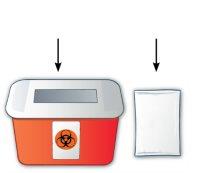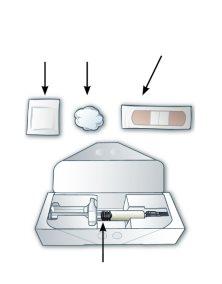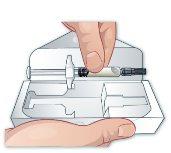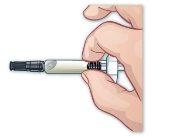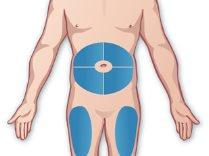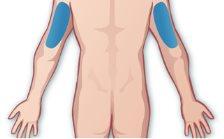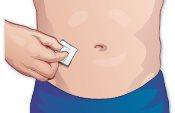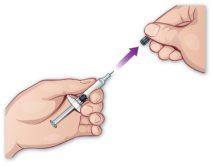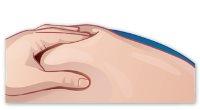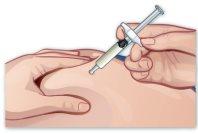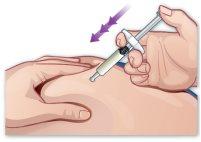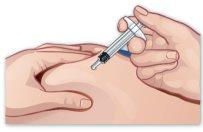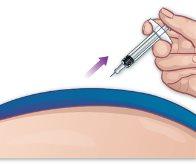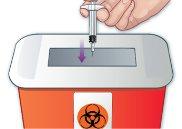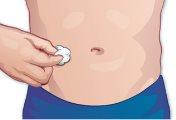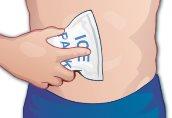
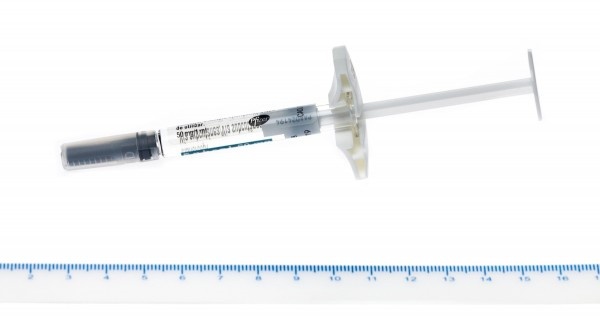
WAYLIVRA 285 mg SOLUÇÃO INJETÁVEL EM SERINGA PREENCHIDA

Pergunte a um médico sobre a prescrição de WAYLIVRA 285 mg SOLUÇÃO INJETÁVEL EM SERINGA PREENCHIDA

Como usar WAYLIVRA 285 mg SOLUÇÃO INJETÁVEL EM SERINGA PREENCHIDA
Introdução
Prospecto: informação para o utilizador
Waylivra 285 mg solução injetável em seringa pré-carregada
volanesorsén
Este medicamento está sujeito a monitorização adicional, o que agilizará a detecção de nova informação sobre a sua segurança. Pode contribuir comunicando os efeitos adversos que possa ter. A parte final da secção 4 inclui informação sobre como comunicar estes efeitos adversos.
Leia todo o prospecto atentamente antes de começar a usar este medicamento, porque contém informação importante para si.
- Conservar este prospecto, porque pode ter que voltar a lê-lo.
- Se tiver alguma dúvida, consulte o seu médico, farmacêutico ou enfermeiro.
- Este medicamento foi prescrito apenas para si, e não deve dá-lo a outras pessoas, mesmo que tenham os mesmos sintomas que si, porque pode prejudicá-las.
- Se experimentar efeitos adversos, consulte o seu médico, farmacêutico ou enfermeiro, mesmo que se trate de efeitos adversos que não aparecem neste prospecto. Ver secção 4.
Conteúdo do prospecto
- O que é Waylivra e para que é utilizado
- O que precisa saber antes de começar a usar Waylivra
- Como usar Waylivra
- Efeitos adversos possíveis
- Conservação de Waylivra
- Conteúdo do envase e informação adicional
1. O que é Waylivra e para que é utilizado
Waylivra contém o princípio ativo volanesorsén, que ajuda a tratar uma doença que se denomina síndrome de quilomicronemia familiar (SQF, por sua sigla em inglês). O SQF é uma doença genética que dá lugar a níveis anormalmente altos no sangue de um tipo de gorduras chamadas triglicéridos. Isso pode dar lugar a uma inflamação do pâncreas, o que é muito doloroso. Junto com uma dieta baixa em gorduras, Waylivra ajuda a reduzir a concentração de triglicéridos no sangue.
Pode que lhe prescrevam Waylivra após ter recebido outros medicamentos para reduzir os níveis de triglicéridos no sangue que não tenham tido efeito suficiente.
Apenas receberá Waylivra se o teste genético confirmar que padece SQF e se considera que o seu risco de pancreatite é muito elevado.
Durante o tratamento com Waylivra, deverá seguir com a dieta baixa em gorduras que o seu médico lhe prescreveu.
Este medicamento é para pacientes com 18 anos ou mais.
2. O que precisa saber antes de começar a usar Waylivra
Não use Waylivra:
- se é alérgico ao volanesorsén ou a algum dos outros componentes deste medicamento (incluídos na secção 6).
- se padece um distúrbio que se denomina trombocitopenia, que consiste em ter muito poucas plaquetas no sangue (menos de 140 × 10^9/l). Pode notá-lo se tiver uma ferida que sangra e demora muito a parar de sangrar (mais de 5 a 6 minutos para um arranhão na pele). O seu médico fará um exame para saber se é assim antes de lhe administrar este medicamento. Pode que não saiba que tem esta afecção nem o que a pode ter causado.
Se alguma das situações anteriores se aplica a si, ou se não tem certeza, consulte o seu médico, enfermeiro ou farmacêutico antes de usar Waylivra.
Advertências e precauções
Consulte o seu médico, farmacêutico ou enfermeiro antes de começar a usar Waylivra se apresentar ou tiver apresentado algum dos seguintes problemas médicos:
- Níveis de triglicéridos muito altos, mas não devidos ao SQF.
- Um número baixo de plaquetas (trombocitopenia), um tipo de células do sangue que se unem para ajudar a coagular; antes de começar a usar este medicamento, o médico fará um exame de sangue para medir o número de plaquetas que tem no sangue.
- Problemas hepáticos ou renais de qualquer tipo.
Exame de sangue
Antes de usar este medicamento, o seu médico fará um exame para medir o número de plaquetas e, após isso, a intervalos regulares, enquanto receber Waylivra para controlar o número de plaquetas.
Consultará o seu médico imediatamente se tiver algum sinal que indique um nível baixo de plaquetas, como hemorragia incomum ou prolongada, manchas vermelhas na pele (chamadas petéquias), cardenales inexplicáveis, hemorragias que não param, hemorragia nasal, ou se apresentar rigidez no pescoço ou um forte dor de cabeça.
Também pode que o seu médico peça um exame de sangue a cada 3 meses para verificar se há algum problema com o fígado. Consultará com o seu médico imediatamente se apresentar sinais de dano hepático, como ter a pele e os olhos de cor amarela, dor ou inchaço do abdômen, tontura, confusão ou sensação geral de mal-estar.
Se for necessário, o seu médico mudará a frequência de administração deste medicamento, ou o suspenderá por algum tempo. Pode ser preciso consultar um médico especialista em distúrbios do sangue para determinar se pode continuar a receber Waylivra.
Exame de urina
Pode que o seu médico peça exames de urina ou de sangue a cada 3 meses para controlar o estado dos rins. Consultará o seu médico imediatamente se apresentar sinais de dano renal, como inchaço nos tornozelos, pernas e pés, diminuição da quantidade de urina expelida, dificuldade para respirar, tontura, confusão ou cansaço ou sonolência intensos.
Dieta
Antes de começar a receber este medicamento, deverá seguir uma dieta projetada para ajudá-lo a baixar o nível de triglicéridos no sangue.
É importante que mantenha esta dieta para baixar os triglicéridos enquanto receber Waylivra.
Crianças e adolescentes
Não use Waylivra se tiver menos de 18 anos. Waylivra não foi estudado em pacientes menores de 18 anos.
Outros medicamentos e Waylivra
Informar o seu médico ou farmacêutico se está a usar, usou recentemente ou pode ter que usar qualquer outro medicamento. É importante que avise o seu médico se receber tratamento com algum dos seguintes:
- Medicamentos para impedir que se formem coágulos de sangue, p. ex., ácido acetilsalicílico, dipiridamol ou warfarina.
- Outros medicamentos que podem modificar a coagulação do sangue, como os anti-inflamatórios não esteroideos como o ibuprofeno, medicamentos que se usam para prevenir o infarto do miocárdio e os acidentes vasculares cerebrais, como o clopidogrel, o ticagrelor e o prasugrel, antibióticos como a penicilina, medicamentos como a ranitidina (que se usa para reduzir a acidez estomacal) e a quinina (que se usa para tratar a malária).
- Medicamentos que podem causar problemas de fígado, como o paracetamol.
Uso de Waylivra com álcool
Desconhece-se o efeito de usar Waylivra com álcool. Deve evitar beber álcool durante o tratamento com este medicamento, devido ao risco de problemas hepáticos.
Gravidez e amamentação
Se está grávida ou em período de amamentação, acredita que possa estar grávida ou tem intenção de engravidar, consulte o seu médico ou farmacêutico antes de usar este medicamento. É preferível evitar o uso de Waylivra durante a gravidez.
Condução e uso de máquinas
É pouco provável que Waylivra afete a sua capacidade de conduzir ou de usar máquinas.
Waylivra contém sódio
Este medicamento contém menos de 1 mmol de sódio (23 mg) por dose; isto é, é essencialmente “isento de sódio”.
3. Como usar Waylivra
Siga exatamente as instruções de administração deste medicamento indicadas pelo seu médico. Em caso de dúvida, consulte novamente o seu médico ou farmacêutico.
Antes de administrar-lhe este medicamento, o seu médico deverá descartar outras causas de elevação dos triglicéridos, como diabetes ou problemas de tireoide.
O seu médico indicar-lhe-á com que frequência se deve administrar este medicamento. Pode mudar a frequência com que deve usá-lo ou pedir-lhe que deixe de recebê-lo durante um tempo ou para sempre, dependendo dos resultados dos exames de sangue e de urina ou da ocorrência de efeitos secundários.
Ser-lhe-á ensinado (a si ou ao seu cuidador) a usar Waylivra seguindo as instruções deste prospecto. Waylivra deve ser injetado debaixo da pele (administração subcutânea, ou SC) tal como lhe ensinou o médico, o enfermeiro ou o farmacêutico, e verificar que se injetou todo o líquido da seringa. Cada seringa pré-carregada de dose única deste medicamento administra uma dose de 285 mg em 1,5 ml.
Antes de usar este medicamento, é importante que leia, compreenda e siga minuciosamente as instruções de administração.
As instruções de uso são apresentadas no final deste prospecto.
Se usar mais Waylivra do que deve
Se injetar demasiada Waylivra, contacte o seu médico ou farmacêutico, ou acuda a urgências imediatamente, mesmo que não apresente sintomas.
Se esquecer de usar Waylivra
Não tome uma dose dupla para compensar as doses esquecidas. Se esquecer de administrar uma dose e se dar conta antes de que tenham passado 48 horas da hora prevista, administre a dose esquecida o mais breve possível. Mas se passaram mais de 48 horas, deverá esperar pela próxima administração prevista. Não se deve injetar mais de uma dose num período de 2 dias.
Se interromper o tratamento com Waylivra
Não deixe de se administrar Waylivra sem antes ter falado com o seu médico.
Se tiver alguma outra dúvida sobre o uso deste medicamento, pergunte ao seu médico, farmacêutico ou enfermeiro.
4. Efeitos adversos possíveis
Como todos os medicamentos, este medicamento pode produzir efeitos adversos, embora nem todas as pessoas os sofram.
Efeitos adversos graves
Se apresentar algum dos seguintes efeitos adversos, contacte o seu médico imediatamente:
- Sintomas que possam indicar que o número de plaquetas no sangue é baixo (as plaquetas são células importantes para a coagulação do sangue). Consultará o seu médico imediatamente se apresentar sinais de que o número de plaquetas é baixo, como hemorragia incomum ou prolongada, aparecimento de manchas vermelhas na pele (denominadas petéquias), cardenales inexplicáveis, hemorragias que não param ou hemorragia nasal, ou se apresentar rigidez no pescoço ou um forte dor de cabeça.
Outros efeitos adversos
Muito frequentes(podem afetar mais de 1 em cada 10 pessoas)
- Reações na zona de injeção (erupção, dor, vermelhidão, calor, secura, inchaço, picazón, formigamento, endurecimento, rash, bolhas, granulos, hematoma, hemorragia, entorpecimento, palidez, mudança de cor ou sensação de queimadura na zona de injeção). Pode reduzir a probabilidade de apresentar uma reação na zona de injeção se esperar que Waylivra atinja a temperatura ambiente antes de injetá-la e aplicar gelo na zona de injeção após fazê-lo.
- Dor de cabeça
- Dor muscular
- Calafrios
Frequentes(podem afetar até 1 em cada 10 pessoas)
- Níveis anormalmente altos de leucócitos nos exames de sangue
- Níveis anormalmente baixos de leucócitos (o que se conhece como linfopenia) nos exames de sangue
- Facilidade para a formação de cardenales ou excesso deles, ou aparecimento de cardenales sem causa evidente
- Hemorragia sob a pele que parece uma erupção, hemorragia nas gengivas ou na boca, presença de sangue na urina ou nas fezes, sangrar pelo nariz ou ter uma menstruação anormalmente abundante
- Reação alérgica, cujos sintomas podem ser erupção cutânea, rigidez articular ou febre
- Presença de sangue ou de proteínas na urina
- Mudanças nos resultados de determinados exames de sangue, como:
- aumento dos níveis de alguns componentes do sangue: creatinina, ureia, transaminases, enzimas hepáticas
- aumento do tempo de coagulação
- diminuição da concentração de hemoglobina no sangue
- diminuição da taxa de filtração do sangue nos rins
- Diabetes, cujos sintomas podem ser aumento da sede, necessidade de urinar com frequência (sobretudo à noite), fome extrema, cansaço intenso e perda de peso inexplicável
- Dificuldade para dormir
- Entorpecimento, formigamento ou picazón, sensação de desvanecimento ou desmaio, tontura ou agitação
- Distúrbios da visão, como visão de flashes ou breve cegueira transitoria em um olho, hemorragia sob a superfície do olho ou visão turva
- Pressão arterial alta
- Aquecimento, aumento da sudorese, sudorese noturna, sensação de calor, doença de tipo gripal ou sensação geral de mal-estar
- Tosse, dificuldade respiratória, congestão nasal, inchaço da garganta, sibilância
- Sensação de doença, boca seca, diarreia, inchaço do pescoço, da face ou das gengivas, dor ou inflamação do estômago, dispepsia
- Vermelhidão da pele, erupção, granos, engrossamento ou aparecimento de cicatrizes ou o picazón da pele que se conhece como urticária
- Dor nas mãos ou pés, dor nas grandes articulações de braços e pernas, o que inclui cotovelos, punhos, joelhos e tornozelos, outro tipo de dor ou rigidez articular, dor nas costas, dor no pescoço, dor na mandíbula, espasmos musculares ou outros dores corporais
- Cansaço intenso, fraqueza ou falta de energia, retenção de líquidos, dor torácica não relacionada com o coração.
Comunicação de efeitos adversos
Se experimentar algum tipo de efeito adverso, consulte o seu médico, farmacêutico ou enfermeiro, mesmo que se trate de possíveis efeitos adversos que não aparecem neste prospecto. Também pode comunicá-los diretamente através do Sistema Español de Farmacovigilancia de Medicamentos de Uso Humano: www.notificaRAM.es. Mediante a comunicação de efeitos adversos, pode contribuir para fornecer mais informação sobre a segurança deste medicamento.
5. Conservação de Waylivra
Mantenha este medicamento fora da vista e do alcance das crianças.
Não use este medicamento após a data de validade que aparece na caixa e na etiqueta da seringa após «EXP». A data de validade é o último dia do mês que se indica.
Conservar na geladeira (entre 2 ºC e 8 ºC).
Conservar na caixa original para protegê-lo da luz.
Waylivra pode estar à temperatura ambiente (até 30 ºC) na caixa original até 6 semanas após retirá-lo da geladeira. Durante esse tempo, e conforme necessário, este medicamento pode estar à temperatura ambiente ou na geladeira. Registre a data em que retirou o envase pela primeira vez da geladeira no espaço indicado na caixa. Se não o usar nas 6 semanas posteriores à primeira vez que o retirou da geladeira, descarte o medicamento. Se durante o período de 6 semanas em que a seringa pode estar à temperatura ambiente passar a data de validade que consta na sua etiqueta, não use a seringa e descarte-a.
Não use este medicamento se observar que a solução está turva ou que contém partículas, deve ser transparente e incolora a amarelo pálido.
Os medicamentos não devem ser jogados nos esgotos nem na lixeira. Pergunte ao seu farmacêutico como se livrar dos envases e dos medicamentos que já não precisa. Dessa forma, ajudará a proteger o meio ambiente.
6. Conteúdo do envase e informação adicional
Composição de Waylivra
- O princípio ativo é o volanesorsén. Cada ml contém 200 mg de volanesorsén sódico, equivalente a 190 mg de volanesorsén. Cada seringa precarregada de dose única contém 285 mg de volanesorsén em 1,5 ml de solução.
- Os demais ingredientes são água para preparações injetáveis, hidróxido de sódio e ácido clorídrico (para ajustar a acidez, ver seção 2, «Sódio»).
Aspecto do produto e conteúdo do envase
Waylivra é apresentado em um envase que contém uma seringa de dose única, com agulha e protetor de agulha, precarregada com uma solução transparente, de incolora a amarelo pálido. Preenchida para administrar 1,5 ml de solução ao empurrar completamente o êmbolo da seringa.
É comercializado em um envase com uma seringa precarregada ou em um envase múltiplo com 4 (4 envases de 1 envase) seringas precarregadas.
Título da autorização de comercialização
Akcea Therapeutics Ireland Ltd.
St. James House
72 Adelaide Road, Dublin 2
D02 Y017
Irlanda
Fabricante
Almac Pharma Services Ireland Ltd.
Finnabair Industrial Estate
Dundalk
Co. Louth
Irlanda
Data da última revisão deste prospecto: 11/2022
Este medicamento foi autorizado com uma «aprovação condicional». Esta modalidade de aprovação significa que se espera obter mais informações sobre este medicamento.
A Agência Europeia de Medicamentos revisará as informações novas sobre este medicamento pelo menos uma vez ao ano e esta ficha técnica ou resumo das características do produto (RCP) será atualizada quando necessário.
Outras fontes de informação
A informação detalhada sobre este medicamento está disponível no site da Agência Europeia de Medicamentos: http://www.ema.europa.eu.
Instruções de uso
Waylivra é uma injeção que se coloca sob a pele com uma seringa precarregada, descartável e de uso único.
Não use Waylivra até que entenda bem o procedimento descrito a seguir. Se tiver alguma dúvida sobre o uso de Waylivra, entre em contato com seu médico ou farmacêutico.
Partes da seringa precarregada



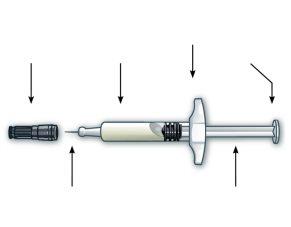
Preparação para a injeção
- Lave as mãos e reúna o necessário para a injeção
Lave as mãos de forma minuciosa com sabão (durante 3 minutos como mínimo) e seque-as bem.
Coloque os seguintes artigos em uma superfície plana e limpa, em uma zona que esteja bem iluminada (Figura A).

|
|
Figura A
- Deixe a injeção atingir a temperatura ambiente
Se a seringa estiver na geladeira, deixe que atinja a temperatura ambiente retirando-a da geladeira pelo menos 30 minutos antes da injeção. Se o líquido injetado estiver frio, pode causar reações na zona de injeção, como dor, vermelhidão ou inchaço. Nãoaqueça a seringa de nenhuma outra forma, nem no micro-ondas nem com água quente. |
Figura B |
- Verifique a data de validade
Verifique a data de validade na caixa. A data de validade que figura no envase refere-se à vida do medicamento quando está refrigerado. A primeira vez que retirar o envase da geladeira, deve anotar a data no espaço indicado na caixa. Nãouse Waylivra se passou a data de validade nem se passaram mais de 6 semanas a temperatura ambiente. Entre em contato com seu médico ou farmacêutico para obter um medicamento novo. |
- Retire a seringa e inspecione o medicamento
Abra a caixa e retire a seringa, segurando-a pelo cilindro e puxando-a até retirá-la (Figura C). |
Figura C |
Observe o líquido da seringa. Deve ser transparente a cor amarelo pálido. É normal ver uma bolha de ar grande (Figura D). Nãotente eliminar a bolha antes da injeção. Não há problema se injetar a solução com a bolha. Nãouse a seringa precarregada se o líquido parecer turvo ou se apresentar partículas flutuantes. |
Figura D |
- Escolha uma zona de injeção
Se for autoadministrar: Abdômen – São mostradas as zonas do abdômen, exceto os 5 cm que rodeiam o umbigo. Coisas – São mostradas as faces da frente e média (Figura E). |
Figura E |
Se um cuidador administrar a injeção, além dessas duas zonas, poderá colocar a injeção em: Braços – Parte de trás do braço, como mostrado (Figura F). Para todas as injeções: Vá rotando as zonas de injeção. Evite injetar na cintura: a roupa pode roçar ou pressionar a zona de injeção. Não injeteem tatuagens, sardas, cicatrizes, marcas de nascimento, hematomas, erupções ou zonas de pele dolorosas ao toque, vermelhas, duras, danificadas, queimadas ou inflamadas. Se não tiver certeza de onde deve colocar a injeção, fale com seu profissional de saúde. |
Figura F |
Injeção
- Prepare a zona de injeção
Limpe a zona escolhida com algodão embebido em álcool (Figura G). |
Figura G |
- Retire o protetor da seringa
Retire o protetor da seringa segurando o cilindro da seringa sem que a agulha aponte para você e retirando o protetor de um puxão (Figura H). Pode haver uma gota de líquido na ponta da agulha. É normal. Nãosegure o êmbolo nem seu apoio quando retirar o protetor de agulha. Nãouse a seringa precarregada se a agulha parecer danificada. Não use a seringa precarregada se cair após retirar o protetor da seringa. |
Figura H |
- Pegue a pele
Pegue a pele que rodeia a zona de injeção com a mão livre (Figura I). |
Figura I |
- Insira a agulha
Insira a agulha na zona de injeção com um movimento rápido e firme, sem tocar o apoio do êmbolo. A agulha deve ser inserida formando um ângulo de 45 graus com a superfície da pele (Figura J). |
Figura J |
- Injete Waylivra
Injete o líquido segurando a seringa com o polegar no êmbolo e empurre devagaraté o final de seu curso, até que a seringa fique completamente vazia (Figuras K e L). |
Figura K |
Figura L |
- Retire a agulha
Retire a agulha da zona de injeção puxando no mesmo ângulo com que a inseriu (Figura M). |
Figura M |
Depois da injeção
- Descarte a seringa usada em um contenedor para objetos perfurantes
Imediatamente após a injeção, descarte a seringa utilizada como indicado por seu profissional de saúde, normalmente em contenedores para descartar objetos perfurantes (Figura N) seguindo os seguintes passos. Descarte o protetor da agulha após a injeção. Nãorecoloque a tampa na seringa. Se não tiver um contenedor para descartar objetos perfurantes, pode descartá-lo em um recipiente de sua casa se:
|
Figura N |
Quando o contenedor para descartar objetos perfurantes estiver quase cheio, deve seguir as diretrizes locais para descartá-lo de forma segura. Pode haver normativa local sobre como descartar as agulhas e seringas usadas. Pergunte a seu farmacêutico ou consulte o site da autoridade sanitária pública local (se aplicável) se desejar saber mais detalhes sobre como descartar os objetos perfurantes em sua localidade. Nãodescarte seu contenedor para objetos perfurantes no lixo. Nãorecicle seu contenedor para objetos perfurantes usados. Mantenha sempre o contenedor para objetos perfurantes fora do alcance de crianças e animais de estimação. |
- Tratamento da zona de injeção
Se sair sangue do local da injeção, pressione um pouco a zona com a bola de algodão estéril ou com a gaze e o aposto, se necessário (Figura O). Nãoesfregue a zona após a injeção. |
Figura O |
Também pode aplicar gelo na zona de injeção para reduzir a dor, a vermelhidão ou a molestia (Figura P). |
Figura P |
Conservação
Informação sobre a conservação
A primeira vez que receber Waylivra, deve conservar as seringas precarregadas em seu envase na geladeira (entre 2 ºC e 8 ºC) Waylivra pode ser conservado a temperatura ambiente (entre 8 ºC e 30 ºC) na caixa protegida da luz durante 6 semanas como máximo. Durante essas 6 semanas, este medicamento pode ser conservado a temperatura ambiente ou na geladeira. Nãocongele a seringa precarregada de Waylivra. Nãoretire o envase nem o protetor de agulha até estar pronto para a injeção. Descarte este medicamento imediatamente se não o tiver usado nas 6 semanas seguintes à primeira vez que o retirou da geladeira. Para ter certeza, consulte a data que anotou na caixa. |
- País de registo
- Substância ativa
- Requer receita médicaSim
- Fabricante
- Esta informação é apenas para referência e não constitui aconselhamento médico. Consulte sempre um médico antes de tomar qualquer medicamento. A Oladoctor não se responsabiliza por decisões médicas baseadas neste conteúdo.
- Alternativas a WAYLIVRA 285 mg SOLUÇÃO INJETÁVEL EM SERINGA PREENCHIDAForma farmacêutica: COMPRIMIDO, 10 mg de ezetimibaSubstância ativa: ezetimibeFabricante: Organon Salud S.L.Requer receita médicaForma farmacêutica: CÁPSULA, 1000 mgSubstância ativa: omega-3-triglycerides incl. other esters and acidsFabricante: Kern Pharma S.L.Requer receita médicaForma farmacêutica: CÁPSULA, 1000 mgSubstância ativa: omega-3-triglycerides incl. other esters and acidsFabricante: Strides Pharma (Cyprus) LimitedRequer receita médica
Alternativas a WAYLIVRA 285 mg SOLUÇÃO INJETÁVEL EM SERINGA PREENCHIDA noutros países
As melhores alternativas com o mesmo princípio ativo e efeito terapêutico.
Alternativa a WAYLIVRA 285 mg SOLUÇÃO INJETÁVEL EM SERINGA PREENCHIDA em Ukraine
Médicos online para WAYLIVRA 285 mg SOLUÇÃO INJETÁVEL EM SERINGA PREENCHIDA
Avaliação de posologia, efeitos secundários, interações, contraindicações e renovação da receita de WAYLIVRA 285 mg SOLUÇÃO INJETÁVEL EM SERINGA PREENCHIDA – sujeita a avaliação médica e regras locais.








